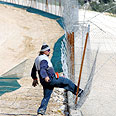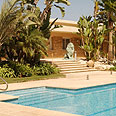

The report found that barriers have been erected between Caesarea and Jisr e-Zarka, Jouarish and the Geneh Dan neighborhood in Ramle, and the Pardes Shanir neighborhood in Lod and Nor Tzvi.
“The purpose of these fences is to separate Jewish quarters from Palestinian quarters, prevent physical and eye contact, and ‘protect’ the Jewish majority from the Arab minority,” the report read.
"The Arab Association for Human Rights believes these fences and barriers are a reflection of a ‘racial segregation’ and ghetto mentality, which is rooted in institutions and pervasive among Jewish communities against the Palestinian minority.”
Entitled “Behind the barriers - Separation barriers and fences between Jews and Arabs in mixed cities and communities in Israel”, the 18-page report compiled by Attorneys Tarek Ibrahim and Yamen Ravk of the Association, and was funded by the European Union and the Interchurch Organization for Development Co-operation, a Dutch organization.
Israeli segregation
“The State of Israel is characterized by territorial segregation between the Jewish majority and the Palestinian minority. Most minority Palestinians and majority Jews live in separate neighborhoods. The territorial segregation is also exists in mixed towns where minority Palestinians and majority Jews live in segregated neighborhoods,” the report said.
Most residents of Arab neighborhoods are opposed to segregation and the construction of fences, which fosters a feeling of inferiority.
As for the rampart being erected between Caesarea and Jisr e-Zarka, the report noted that “in November 2002, residents of Jisr e-Zarka were surprised to hear that a rampart would be erected to separate between the two towns.”
Caesarea residents complain of loud Arab neighbors
The Caesarea-e-Zarka rampart is 4-5 meters high and stretches along 1.5 kilometers. The report said that according to the Caesarea municipality, the fence was built to protect local residents from “the blow” of burglaries stemming from Jisr e-Zrka.
Caesarea residents have also complained of their Arab neighbor’s habits of listening to loud music, partying and firing in the air during marriages and other ceremonies, activities that spawn excessive noise.
“It is difficult to accept these arguments. The wall is not protective against noise, does not prevent crossings and remains breached. Residents feel the rampart was erected to make them feel uneasy and leave,” the report said.
The report also claims that attempts by Arab families to live in neighborhoods built for Jews was met by staunch resistance from racially motivated Jewish residents.
In March 2004, residents of the Migdal residential area near the Sea of Galilee hung signs in the town reading, “Danger to Migdal and its residents!!! WAKE UP!!! They are demanding to destroy Migdal now that they have taken over the whole country!!!”
Residents of the Jewish neighborhood of Pardes Snir in Ramle argue that a fence built between them and their Arab neighbors in Nir Zvi is meant to “protect.”
They complained that real estate in their neighborhood is 40 percent lower than other neighborhoods due to its proximity to Arab communities.
“This phenomenon conceals an explosive potential and torpedoes all attempts to establish proper relations and normal coexistence between the two communities," report initiators said, adding that the report sought to draw the attention of the international community to the problem.















